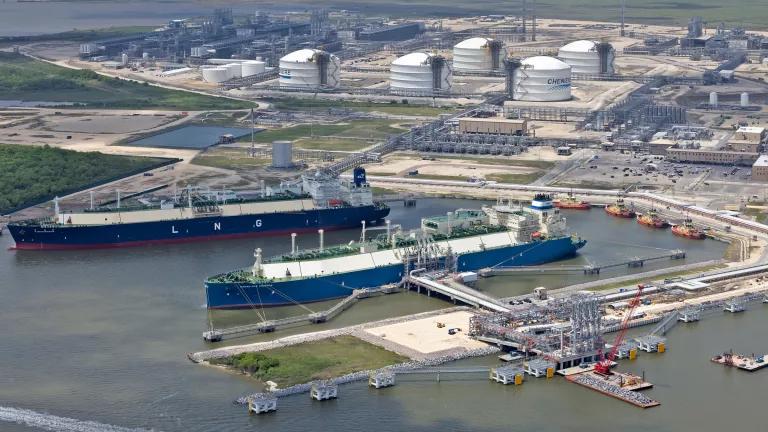Consumer Pain as Oil Profits Soar and Production Stays Flat
Here’s a snapshot of results from the 15 oil companies we tracked.

Offshore oil rig by C. Morrison
Corporations are profiting from consumers’ pain at the gas pump. While soaking consumers at the pump, 15 of the largest oil and gas companies banked a record $77 billion in second-quarter profits, nearly triple the level of a year ago, bringing their take to nearly $94 billion in just the first half of 2022. Meanwhile, second-quarter production from these companies fell below last year’s levels, as they lavished shareholders with more than $30 billion in stock buybacks and dividend checks.
From a global energy crisis triggered by Russia’s war on Ukraine, the oil industry has drawn a single lesson: High prices at the pump mean record profits. Our families have gotten the message as well—one costly fill-up at a time.
NRDC is tracking the profits of the 15 largest oil and gas companies with substantial production and operation footprints in the United States. As our complete figures now show, while people paid the price at the pump this spring, Big Oil raked in record profits last quarter with an astonishing 288 percent jump above last year’s second quarter profits.
And on top of those profits, Big Oil doled out more than $20 billion to buy back stocks from shareholders and paid dividends to shareholders worth well over $10 billion. Oil executives haven’t been shy in describing the situation—it's “an embarrassment of riches.”
Here’s a snapshot of results from the 15 companies we tracked:
| Company Name | Q2 2022 Net Income | Net Income to Date (2022) | Percent Change Q2 2021 vs Q2 2022 |
| ExxonMobil | $17,850,000,000 | $23,330,000,000 | 226% |
| Chevron | $11,622,000,000 | $17,881,000,000 | 277% |
| Shell | $11,470,000,000 | $20,600,000,000 | 107% |
| BP | $9,257,000,000 | ($11,127,000,000) | 197% |
| ConocoPhillips | $5,759,000,000 | $10,904,000,000 | 486% |
| EOG Resources | $2,238,000,000 | $2,628,000,000 | 147% |
| Occidental Petroleum | $3,555,000,000 | $8,231,000,000 | 3765% |
| Pioneer Natural Resources | $2,371,000,000 | $4,380,000,000 | 524% |
| Valero Energy | $4,700,000,000 | $5,600,000,000 | 2801% |
| Phillips 66 | $3,285,000,000 | $3,880,000,000 | 898% |
| Hess | $667,000,000 | $1,084,000,000 | 1001% |
| Cheniere | $741,000,000 | ($124,000,000) | 325% |
| Coterra Energy | $1,200,000,000 | $1,837,000,000 | 3900% |
| Diamondback Energy | $1,400,000,000 | $2,264,000,000 | 327% |
| Marathon Oil | $934,000,000 | $2,270,000,000 | 5738% |
|
Totals |
$77,049,000,000 | $93,638,000,000 | 288% |
In our last post on this topic, we also highlighted the staggering lack of interest these companies show toward playing a role in the energy transition. Indeed, with nine additional companies now reporting on their activities, only BP joins Shell in disclosing any meaningful information about their investments in renewable energy.
That’s a shocking failure, given the climate disasters occurring almost daily worldwide, not to mention the price we’re all paying for yet another energy shock brought on by our reliance on oil and gas. The industry disingenuously blames President Biden and argues for irresponsible policies that would only deepen our dependence on fossil fuels.
And yet, the industry’s actions on the ground tell a completely different story. Despite record profits, the industry’s capital expenditures indicate little appetite for increasing production. In fact, actual production numbers are lagging when we compared Q2 2022 to Q2 2021:
| Company Name |
Q2 2022 Production (bpd) |
Q2 2021 Production (bpd) |
| ExxonMobil |
2,298,000 (+) |
2,200,000 |
| Chevron |
1,687,000 (-) |
1,847,000 |
| Shell |
1,325,000 (-) |
1,558,000 |
| BP |
935,000 (-) |
938,000 |
| ConocoPhillips |
871,000 (+) |
849,000 |
| EOG Resources |
464,000 (+) |
449,000 |
| Occidental Petroleum |
611,000 (-) |
639,000 |
| Pioneer Natural Resources |
348,000 (-) |
363,000 |
| Hess |
176,000 (+) |
166,000 |
| Coterra Energy |
89,000 (+) |
0 |
| Diamondback Energy |
224,000 (-) |
245,000 |
| Marathon Oil |
167,000 (-) |
170,000 |
|
Totals* |
9,195,000 (-) |
9,424,000 |
* Valero, Phillips 66, and Cheniere are excluded because they are primarily refiners or liquified natural gas producers.
While global production numbers have slowly increased in 2022 across the entire industry, this quarter’s results make clear that companies are not investing in ramping up production to bring prices down. Nor are they sharing this increased revenue by hiring more workers. In fact, even as oil and gas companies raked in billions in COVID-19 relief dollars, they fired 118,000 (and counting) oil and gas workers in the United States the past year alone.
For industry, the plight of energy workers and everyone else just means record profits. For the rest of us, it means a continued disconnection between corporate profits and human wellbeing while prices at the pump are still high and consumers are forced to change behavior in response to the increased cost of living and worsening job prospects. Industry, even awash in profits, has not helped balance supply with demand or provided adequate public benefit to justify the billions they receive in public financial support.
Even in the face of this corporate greed and the economy-wide damage it does, a better energy future is possible and within reach. The transition to renewable energy promises an end to the global price shocks caused by petro-state actions, wars, and disasters. At the same time, gains in efficiency, expanding clean and alternative transit, and investing in homes and buildings will lower the costs consumers must pay to power our lives. The economic benefits of those changes are plain: stability, lower costs, and massive reductions in greenhouse gas emissions and other dangerous pollutants.




